Given a distance matrix and a set of points, how do you figure out the coordinates of these points?
Edit: This is on a plane.
This question was answered here but in trying different distance matrices, I really couldn't use this answer because the M matrix had negative values, as did my eigenvectors. So when you took the square root, the program (in R) outputs "NaN" for those associated entries. I'm guessing this will happen every time D(i,j)^2 is greater than D(1,j)^2 + D(i,1)^2.
For example, say I have a distance matrix:
0 73 102 496 432 184
73 0 303 392 436 233
102 303 0 366 207 353
496 392 366 0 172 103
432 436 207 172 0 352
184 233 353 103 352 0
Using the equation M(i,j) = (0.5)(D(1,j)^2+D(i,1)^2-D(i,j)^2), I get (which already has negative entries):
0 0.0 0.0 0.0 0.0 0.0
0 5329.0 -38038.0 48840.5 928.5 -7552.0
0 -38038.0 10404.0 61232.0 77089.5 -40174.5
0 48840.5 61232.0 246016.0 201528.0 134631.5
0 928.5 77089.5 201528.0 186624.0 48288.0
0 -7552.0 -40174.5 134631.5 48288.0 33856.0
Then I get non - zero eigenvalues & eigenvectors:
477718.27 101845.63 16474.30 -13116.72 -100692.49
[,1] [,2] [,3] [,4] [,5]
0.00000000 0.0000000 0.00000000 0.00000000 0.00000000
-0.05928626 0.3205747 0.84148945 0.04869546 -0.42806691
-0.16650486 -0.5670946 -0.04507520 -0.58222690 -0.55647098
-0.73371713 0.2827320 0.07386302 -0.45957443 0.40627254
-0.59727407 -0.4623603 0.07806418 0.64968004 -0.03617241
-0.27144823 0.5309625 -0.52755471 0.15920983 -0.58372335
Since there are both negative eigenvalues and eigenvectors, when we compute sqrt(eigenvector(i)*eigenvalue(i)), we'll have negative values. Here is my final output:
[,1] [,2] [,3] [,4] [,5]
0 0.0000 0.00000 0.00000 0.00000
NaN 180.6907 117.74103 NaN 207.61291
NaN NaN NaN 87.38939 236.71174
NaN 169.6910 34.88326 77.64089 NaN
NaN NaN 35.86158 NaN 60.35139
NaN 232.5429 NaN NaN 242.43877
Is this the only clear way of computing the coordinate points without using angles? If it is, do we have to fix the distance matrix so D(i,j)^2 is not greater than D(1,j)^2 + D(i,1)^2.
Thanks.

